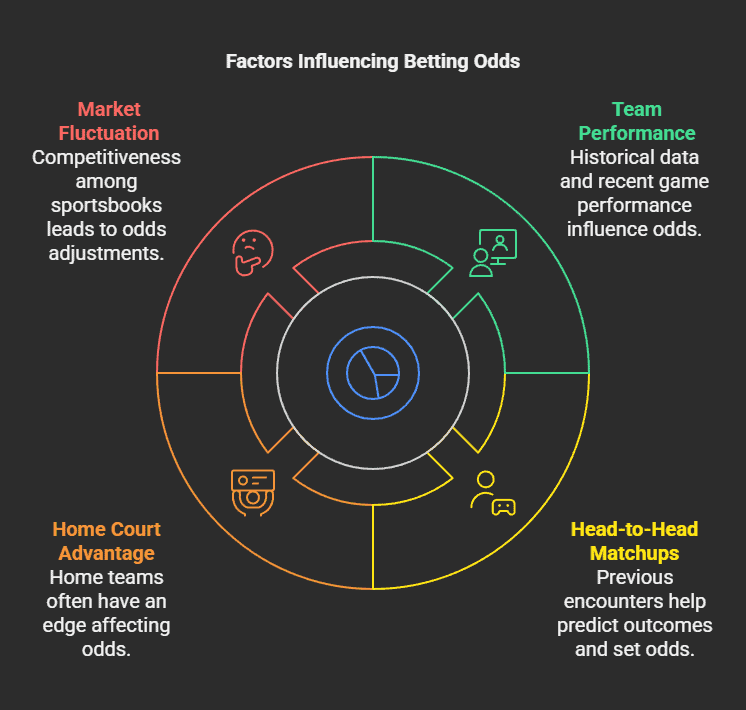Understanding Odds and Lines
Lines and odds are terms you often hear in online sports betting. What do these terms mean, and why are they so crucial for successful sports betting? We’ll answer these questions and show you how a deeper understanding of these concepts can help you make better-informed bets on your favorite sports.
Before we get into the meat and potatoes of our guide to understanding odds and betting lines, let’s establish what odds and betting lines are so you don’t have to dig too deep for the answer. Odds are the likelihood of an outcome in a sports game or event. The line is the margin between the two possible outcomes (the favorite or the underdog winning the game).
So What Are Odds?
Odds are the measurement of the likelihood of an outcome. In the context of sports betting, odds are determined by the betting line, which is the margin between two possible outcomes, where the line lies will dictate the value of the favorite-to-win bet and the underdog bet.
Bookmakers do their best to assign each team or competitor the correct value. However, they make mistakes occasionally, either overvaluing or undervaluing. It’s the job of any good sports bettor to shop the odds and find these cases of misvalue to find a good edge in the numbers and hopefully place a successful bet on a potential upset.

Types of Odds
You’ll find three kinds of odds when using online sports betting apps: American odds, decimal odds, and fractional odds. Your sportsbook will let you switch the format to the one you prefer—it’s entirely up to you how you want your odds to read, no matter which country you hail from.
Speaking of which, specific odds formats are prevalent in certain countries. With American odds, it’s a no-brainer—the preferred odds format in the United States. People from the United Kingdom prefer fractional odds, and people from Australia, Canada, and Europe are partial to the decimal odds format.
So, how do you read these odds, and how can you calculate your payout? We’ll go over each format and show you how everything works!
American Odds
With American odds, the favorite to win is shown by a negative sign (-), and the underdog is shown by a positive sign (+). Check out an example of how American odds will look when you view them in your favorite sportsbook:
Falcons
-500
Eagles
+700
The Falcons are favored to win this game, while the Eagles are the underdog team. If you’re betting on Atlanta, you’re staking $500 to win $100 for a total payout of $600. Betting on the favorite is risky, but not really. You’re staking more money on the favorite than you would the dog, but the favorite is likely to win, so you earn a minimal profit of $100.
If you bet on Philly, you’re taking a risk in the hopes that they can pull out a win and cause a significant upset. It’s been known to happen! For this bet, you must wager $100, and if Philly wins, you get a payout of $700 for a total payout of $800! If you play underdog bets right, you can win a lot more than betting on the favorite.
Fractional Odds
People in Great Britain and Ireland are partial to fractional odds. This format uses backslashes (/) or hyphens (-). A fractional odds example would be 4-1 or (4/1) odds, also known as “four-to-one” odds. This means you can win $4 for every $1 your wager.
Falcons
1/3
Eagles
5/1
Let’s say the oddsmakers offer 4-1 odds on the Eagles winning over the Falcons. You bet $20 on the Eagles, and they win the game. You win $80 in profit ($20 x 4) and get your original wager back, so your payout is $100.
Decimal Odds
Decimal odds are sometimes called continental or digital odds, and they are most used overseas in Europe and Australia. These odds are the preferred format for our Neighbor to the North, Canada. They’re called decimal odds because they are used in the numbers the oddsmakers post to the book.
Let’s take another look at the Atlanta and Philly game:
Falcons
1.4
Eagles
3.0
In this example, the Falcons are still favored to win over the Eagles. 1.4 is the equivalent of -250 in American odds or ⅖ in fractional odds. It’s an implied probability of 71.43%. A bet of $100 on Atlanta would result in a profit of $40 ($100 x 1.4) and a total payout of $140 because you get your original bet back.
Those who bet on the Eagles need Philly to pull off the upset for the bet to be considered a win. 3.00 equals +200 in American odds, with an implied probability of 33.33%. Betting $100 on Philly would result in a profit of $200 and a total payout of $300 if the Eagles win over the Falcons.
Reading the Odds
Discover how to read American, fractional, and decimal odds. Knowing the numbers and symbols signify, you can start developing a successful betting strategy. As mentioned, online sportsbooks are good about including all odds formats and letting bettors switch from one format to another.
American Odds
- Falcons -500
- Eagles +700
A negative number always indicates the favorite to win, and a positive number always indicates the underdog. For a bet on the favorite, you must stake the amount of the odds list, in this case, $500. If the favorite wins, you earn $100 for a total payout of $600.
If you bet on the underdog to win, you only have to wager $100, but if they pull off an upset and win, you can earn the amount of the odds lists, in this case, $700. If the underdog wins, you warn a whopping $700, and you get your original bet back, so your total payout is $800.
Fractional Odds
- Falcons: 4-1 or 4/1
- Eagles 2-5 or 2/5
In the example above, the Falcons are favored to win with 4-1 odds. The 1 represents the dollar amount you’re staking, while the 4 represents the amount you can win for each unit you stake. You’re earning $4 for every $1 bet on the Falcons.
Decimal Odds
- Falcons: 1.4
- Eagles: 3.00
The decimal numbers above represent the money you could win for every $1 you stake. If you place $100 on the Eagles, multiply $100 by 3.00 to figure out your total payout ($300). You get your original wager back as a part of your $300 payout, so you made a profit of $200. Betting on the Falcons is a profit of $40 and a total payout of $140, so you make more money betting on the dog if they’re the ones to win.
What Are Betting Lines?
The betting line is the marker that sportsbooks use to gauge the odds for the underdog team and the favorite team. It’s the margin between two different outcomes of the game. Bookmakers set up betting odds based on the amount of public money staked on a specific game, match, or event. As the amount staked changes, the bookmakers will adjust the lines to keep as much action as possible on both sides. If there’s a significant imbalance in action, bookmakers will move the line to make the underrepresented side more appealing.
Keeping the action even on both sides is the sportsbook’s way of staying profitable. Think about it. If many people are betting on the favorite and that team wins, the sportsbook will lose a ton of money covering all the payouts. When the action is even on both sides, this is ideal because no matter the final outcome, the sportsbook is insulated against having to pay a whole lot.
Types of Betting Lines
The three most popular kinds of bets you’ll usually find using a real-money sports book are the straight bets. They are the first three options when viewing the odds and selecting bets to add to your slip.
Point Spread
These are bets designed around bettors correctly predicting the margin of victory in a game. Point spreads are set up to even the playing field a bit and motivate bettors to place wagers on the underdog team. For an example of how these work, say you have a team that is the -3 point favorite to win. They need to win outright by over three points for a bet on the favorite to be considered a win. The bet for the +3 underdog will be a win if they win outright over the favorite or lose the game by less than three points.
Point spreads can shift based on betting behavior, where most punters place money on one side of the bet. This can occur when bettors find more valuable odds, like the higher positive value on the money line, when a change in the number of points given or taken away occurs for a specific team, or when there’s a change in the predicted points total of the game.
Moneyline
This is the most straightforward sports bet on a game, match, or event winner. The final margin of victory doesn’t factor in the bet as it would with a point spread or total bet.
Betting the moneyline can be tricky because upsets are known to happen, and your entire bet could go bust. For these bets to succeed, you need to know both teams well. Does the underdog stand a chance of pulling off an upset? If that’s the case, this scenario is where you could make the most money because betting the moneyline on the favorite doesn’t result in a huge payday. If the dog is not likely to win, consider betting the point spread instead.
Totals (Over/Under)
The bookmakers will try to correctly predict the total number of points scored for a game or match, and then bettors can bet if the final combined score comes under or over this number.
Movements for total lines can come with uneven action on a single side of the bet. For instance, if there are tons of bettors betting the “under” and there’s not much action over on the “over” side of the bet, the line will adjust to make betting on the “over” side a bit more enticing.
How Odds and Lines Are Set
Just as bettors are out to make money when they bet on sports, sportsbooks are also interested in making a profit—they take a small cut from both sides of any bet. This means it’s essential for them to drum up interest in both sides of the set line to ensure they remain profitable on either side. It’s a technique to hedge against unexpected outcomes.
The opening line for any game, match, or event is simply a jumping-off point. The lines are subject to change as the public introduces the bet and the bookmakers attempt to move the line to keep betting action even on both sides.
Here are a few factors that bookmakers consider when they develop the initial odds for the favorites and underdogs of any given bet:

Team/Player Performance: Bookmakers will look at historical data on each team and individual player to determine the likelihood of a victory on either side. Often, this involves looking back on the recent games and noting if the team or competitor is gaining momentum or if there has been poor performance. This information usually gives bookmakers a good indication of who the favorite and the underdog might be. Teams performing stronger than the other will be the favorite to win.
Head-to-Head Matches: Bookmakers will form hypothetical head-to-head matchups between teams or players using the data they have on hand from previous performances. These matchups help to identify patterns or tendencies that could work to a team’s or individual player’s advantage.
Home Court Advantage: Teams playing on their home field or court likely have an advantage over the other team based on the crowd attending the event. Bookmakers will use this information to judge their odds for favorite and underdog teams. Favorite teams playing at home are likely to win, while underdogs might still lose but overperform expectations, which could lead to attractive point-spread betting opportunities.
Market Fluctuation: Bookmakers will base their odds around rival sportsbooks posting numbers. Sportsbooks are businesses that want to be competitive in what they offer, so they will adjust their numbers to make them more enticing than their competition. Obviously, sportsbooks will research every bet and try to offer odds that best reflect the actual likelihood of each outcome, so you’ll see the same variation, but many of the numbers between sportsbooks paint the same picture.
Bookmakers use other factors to create the initial odds, but these are the most significant. Another subject is the factors that dictate line movement and a changeup in the odds—we’ll cover this in the next section, where we discuss inevitable line movement in sports betting, whether significant or minor.
Odds and Lines Movement
Any sports bettor knows that the odds are subject to change in online sports betting. Changes in the odds can cause line movement one way or another. Many sharps and professional bettors know this, and they tend to place their bets right before a game because they know that a sportsbook will try to offer value to the opposing side to even out the betting action. Professionals will spring at the last minute on these opportunities after extensive research and finding the value they’re looking for.
But what influences a change in odds anyway?
While the odds are set using historical data from players’ or teams’ past performances, hypothetical head-to-head matchups, market fluctuation, and the venue of the game, several factors cause the odds to shift after the bookmakers have introduced them to the sports betting site. These external factors can change the likelihood of either outcome, so bookmakers will make adjustments, causing the lines to move.
Weather Conditions: Factors like the weather can significantly impact the final outcome. If the weathermen call for rain, snow, or sleet on game day, the likelihood of either team winning can change.You could have an underdog team that’s likely to lose only by a little and suddenly get a new lease on life because they have historically performed better in bad weather than their favorite team.
Injuries or Suspensions: When key players get injured or face a suspension from certain games, this can significantly impact how a team might fare against its competitor. Bookmakers will adjust their odds if significant injuries or suspensions occur that change the entire fabric and dynamics of the game. There tend to be more intense changes in the numbers if it’s a significant player whose contributions cannot be easily replaced. Some injuries or suspensions don’t even cause an upset in the number, so the odds will tend to stay the same if they have minimal impact on the overall outcome.
Public Opinion/Media Influence: The betting public tends to flock to one team or competitor as the favorite, so one side will get much of the betting action. In an attempt to even out the action, sportsbooks will generate action for the underdog to get bettors to put their money on the other side. Bookmakers will put out competitive point spread bets or money lines that don’t require much risk (but offer a lot of reward in the case of an upset). As more bettors place wagers on the other side, the odds change for the favorite as the betting line shifts.
Economic Factors: In bull markets, there’s much more betting participation because people tend to have more money to dedicate to online sports betting. In a bad economy, you tend to see fewer people betting (those who are responsible, anyway), which means less action and fewer bets being placed. These are times when sportsbooks might offer enticing odds to get people interested in betting. Bad economies are when you can find some great value on the odds sportsbooks provide.
Regulatory Changes/Legal Developments: Bookmakers will begin adjusting odds when regulatory changes or legal developments occur where sports betting is either legalized or outlawed in various countries, jurisdictions, states, or municipalities. Sportsbooks could get an influx of new business and must adjust the odds accordingly to handle any potential imbalance in new action.
Common Mistakes to Avoid
If you’re learning about odds and lines in sports betting, it’s easy to fall prey to newbie mistakes when using a sportsbook for the first time. We’d love to see you sidestep some of these common pitfalls and develop healthy betting habits early on. Read up on the most significant betting mistakes surrounding odds and lines and ways to use betting strategy to your advantage, even if you’re new to everything!
Overreliance on Favorites
Betting the favorite all the time is one of the worst mistakes you could make in sports betting. There’s a time and place to bet on the team that will likely win, but you’ll miss out on golden opportunities by overlooking underdog odds that contain value. Truth be told, the payouts you can earn from underdog upsets will almost always be better than the middling payouts you earn from an anticipated favorite victory.

Misunderstandings Underdogs
Betting on the underdog is a way for the sportsbook to balance action on both sides of the betting line. Betting the dog isn’t a guaranteed loss. No, these can be some of the most lucrative bets, but you must be shopping for value before placing these bets. Wager on the underdog if an upset is entirely possible.
Glossary of Terms
You may or may not be familiar with the betting terminology in our guide. Use our sports betting glossary to learn about the lingo we use around here so you better understand what we’re talking about. The more you know about these concepts, the more savvy you will become in betting on sports.
.
